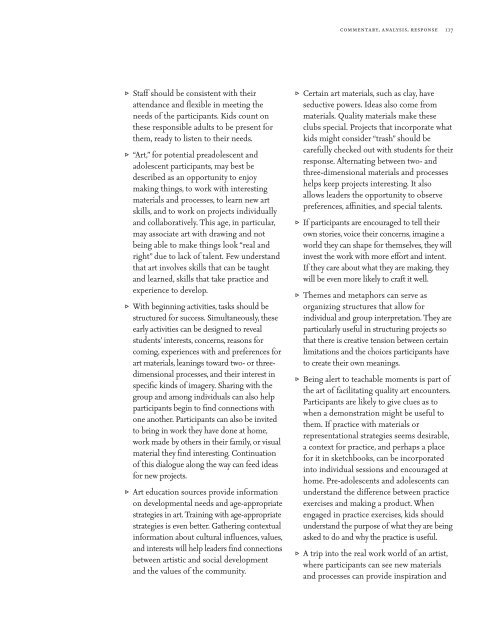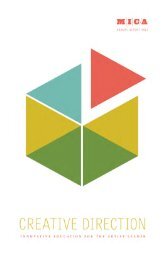art/vision/voice - Maryland Institute College of Art
art/vision/voice - Maryland Institute College of Art
art/vision/voice - Maryland Institute College of Art
You also want an ePaper? Increase the reach of your titles
YUMPU automatically turns print PDFs into web optimized ePapers that Google loves.
v Staff should be consistent with their<br />
attendance and flexible in meeting the<br />
needs <strong>of</strong> the p<strong>art</strong>icipants. Kids count on<br />
these responsible adults to be present for<br />
them, ready to listen to their needs.<br />
v “<strong>Art</strong>,” for potential preadolescent and<br />
adolescent p<strong>art</strong>icipants, may best be<br />
described as an opportunity to enjoy<br />
making things, to work with interesting<br />
materials and processes, to learn new <strong>art</strong><br />
skills, and to work on projects individually<br />
and collaboratively. This age, in p<strong>art</strong>icular,<br />
may associate <strong>art</strong> with drawing and not<br />
being able to make things look “real and<br />
right” due to lack <strong>of</strong> talent. Few understand<br />
that <strong>art</strong> involves skills that can be taught<br />
and learned, skills that take practice and<br />
experience to develop.<br />
v With beginning activities, tasks should be<br />
structured for success. Simultaneously, these<br />
early activities can be designed to reveal<br />
students’ interests, concerns, reasons for<br />
coming, experiences with and preferences for<br />
<strong>art</strong> materials, leanings toward two- or threedimensional<br />
processes, and their interest in<br />
specific kinds <strong>of</strong> imagery. Sharing with the<br />
group and among individuals can also help<br />
p<strong>art</strong>icipants begin to find connections with<br />
one another. P<strong>art</strong>icipants can also be invited<br />
to bring in work they have done at home,<br />
work made by others in their family, or visual<br />
material they find interesting. Continuation<br />
<strong>of</strong> this dialogue along the way can feed ideas<br />
for new projects.<br />
v <strong>Art</strong> education sources provide information<br />
on developmental needs and age-appropriate<br />
strategies in <strong>art</strong>. Training with age-appropriate<br />
strategies is even better. Gathering contextual<br />
information about cultural influences, values,<br />
and interests will help leaders find connections<br />
between <strong>art</strong>istic and social development<br />
and the values <strong>of</strong> the community.<br />
commentary, analysis, response 117<br />
v Certain <strong>art</strong> materials, such as clay, have<br />
seductive powers. Ideas also come from<br />
materials. Quality materials make these<br />
clubs special. Projects that incorporate what<br />
kids might consider “trash” should be<br />
carefully checked out with students for their<br />
response. Alternating between two- and<br />
three-dimensional materials and processes<br />
helps keep projects interesting. It also<br />
allows leaders the opportunity to observe<br />
preferences, affinities, and special talents.<br />
v If p<strong>art</strong>icipants are encouraged to tell their<br />
own stories, <strong>voice</strong> their concerns, imagine a<br />
world they can shape for themselves, they will<br />
invest the work with more effort and intent.<br />
If they care about what they are making, they<br />
will be even more likely to craft it well.<br />
v Themes and metaphors can serve as<br />
organizing structures that allow for<br />
individual and group interpretation. They are<br />
p<strong>art</strong>icularly useful in structuring projects so<br />
that there is creative tension between certain<br />
limitations and the choices p<strong>art</strong>icipants have<br />
to create their own meanings.<br />
v Being alert to teachable moments is p<strong>art</strong> <strong>of</strong><br />
the <strong>art</strong> <strong>of</strong> facilitating quality <strong>art</strong> encounters.<br />
P<strong>art</strong>icipants are likely to give clues as to<br />
when a demonstration might be useful to<br />
them. If practice with materials or<br />
representational strategies seems desirable,<br />
a context for practice, and perhaps a place<br />
for it in sketchbooks, can be incorporated<br />
into individual sessions and encouraged at<br />
home. Pre-adolescents and adolescents can<br />
understand the difference between practice<br />
exercises and making a product. When<br />
engaged in practice exercises, kids should<br />
understand the purpose <strong>of</strong> what they are being<br />
asked to do and why the practice is useful.<br />
v A trip into the real work world <strong>of</strong> an <strong>art</strong>ist,<br />
where p<strong>art</strong>icipants can see new materials<br />
and processes can provide inspiration and
















